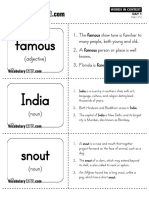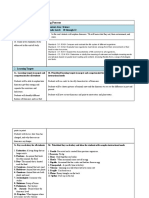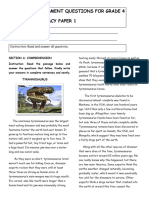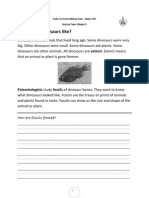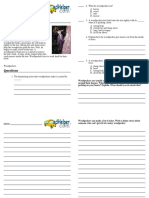Closed Reading 11 - Meet Stegosaurus
Closed Reading 11 - Meet Stegosaurus
Uploaded by
bjy525Copyright:
Available Formats
Closed Reading 11 - Meet Stegosaurus
Closed Reading 11 - Meet Stegosaurus
Uploaded by
bjy525Original Description:
Copyright
Available Formats
Share this document
Did you find this document useful?
Is this content inappropriate?
Copyright:
Available Formats
Closed Reading 11 - Meet Stegosaurus
Closed Reading 11 - Meet Stegosaurus
Uploaded by
bjy525Copyright:
Available Formats
Passage 11
Name ___________________________________________ Date__________________________
Read the paragraph. Then answer the questions.
Meet Stegosaurus
Stegosaurus was an interesting-looking
dinosaur. It had large plates shaped
like triangles along its back. However,
Stegosaurus had a very small head.
Stegosaurus also had weak jaws. It had no
teeth in the front of its jaws. It could not
tear through tough skin. Stegosaurus ate
things it found on the ground.
Comprehension Skills: 40 Short Passages for Close Reading, Grade 3 2012 by Linda Ward Beech, Scholastic Teaching Resources
1. Which sentence is most likely true?
A. Stegosaurus was a plant-eating dinosaur.
B. Stegosaurus had teeth shaped like triangles.
C. Stegosaurus used its mouth for protection.
2. Write fact or opinion next to each sentence.
____________ A. Stegosaurus also had weak jaws.
____________ B. Stegosaurus was an interesting-looking dinosaur.
____________ C. Stegosaurus ate things it found on the ground.
3. In this paragraph, the word weak means
A. powerful.
B. not strong.
C. large.
1. Inference 2. Fact & Opinion 3. Context Clues
17
This student page includes a short passage focusing on three of these essential comprehension skills.
Comprehension Skills At-a-Glance
Use the information that follows to introduce the reading comprehension skills covered in this lesson.
Main Idea & Details
Understanding the main or key idea of a paragraph is crucial for a reader. The main idea is what the paragraph is about. The
other parts of the paragraph help to explain more about this key idea. Sometimes, the main idea is in the first sentence of a
paragraph.
The information that supports the main idea is usually referred to as the details. Details help a reader gain a fuller under-
standing of a paragraph.
Context Clues
Using context means determining an unfamiliar words meaning by studying the phrases, sentences, and overall text with
which the word appears. Context clues help readers comprehend and enjoy a text and also read more smoothly
and efficiently.
Compare & Contrast
Recognizing how events, characters, places, and facts are alike and different helps a reader gain a richer understanding of
a text. Sometimes a reader can learn more about something by finding out what it is not like than what it is like. A
comparison shows similarities, while a contrast shows differences.
Inference
Although most primary students dont know what an inference is, many are most likely making inferencesboth in their
daily lives and when readingwithout being aware of it. Students should understand that writers dont include every detail
Comprehension Skills: 40 Short Passages for Close Reading, Grade 3 2012 by Scholastic Teaching Resources
in their writing; it is up to readers to supply some information. A reader makes a guess or inference by putting together
what is in a text with what he or she already knows. Inferring makes a significant difference in how much a reader gains
from a text.
Predict
Good readers take time to think about a text. One way they do this is by thinking ahead to determine what may happen
next or how an event will unfold. Often, information a reader has come across in the text provides has come across in the
text provides clues to what will happen next. In many cases readers also use what they already know when they make
predictions.
Fact & Opinion
Readers who can identify and differentiate between statements of fact and opinion are better able to analyze and assess a
text. Students should learn to recognize phrases such as I think and you should, that signal opinions.
Answers: page 17:
1 . A
2 . A . Fact
B . Opinion
.
C . Fact
3 . B
You might also like
- Noun 3 PDFDocument15 pagesNoun 3 PDFRt Saragih100% (1)
- Identifying Bones! PDFDocument2 pagesIdentifying Bones! PDFbjy525No ratings yet
- Reading and Listening 4Document3 pagesReading and Listening 4Hải Anh TạNo ratings yet
- Rover Gas TurbineDocument44 pagesRover Gas TurbineJuprayNo ratings yet
- Dinosaur Proj Third Level Second TermDocument10 pagesDinosaur Proj Third Level Second TermMichael sebastian Diaz PulidoNo ratings yet
- Unit 6: AnimalsDocument32 pagesUnit 6: AnimalsDodo.English OnlineNo ratings yet
- Taking Notes - Assessment: Grade: NameDocument6 pagesTaking Notes - Assessment: Grade: NameFlavia GodjaNo ratings yet
- D-SAT Prep 2Document7 pagesD-SAT Prep 2digitalsat5419No ratings yet
- Recognizing Sentences: NameDocument2 pagesRecognizing Sentences: Namembaer99No ratings yet
- (B2) Unit 1 - Great Places To Be - Reading PracticeDocument5 pages(B2) Unit 1 - Great Places To Be - Reading PracticeQuang Huy PhạmNo ratings yet
- Reading Comprehension - DinosaursDocument2 pagesReading Comprehension - Dinosaursmbaer99No ratings yet
- Are You From India - VocabDocument12 pagesAre You From India - VocabSarah ZhaoNo ratings yet
- Standards-Aligned Unit Planning Process: 1. Unit Overview Content Area: Science Grade Level: 10 Through 12Document6 pagesStandards-Aligned Unit Planning Process: 1. Unit Overview Content Area: Science Grade Level: 10 Through 12api-339905937No ratings yet
- Insight Link 1 - Answer Keys - WBDocument19 pagesInsight Link 1 - Answer Keys - WB고서영No ratings yet
- Diplodocus Was Longer Than Most Other Dinosaurs - It Was As Long As Two Buses and A Car! It Had A Very Long Neck and Its Nostrils Were at The Top of Head.Document2 pagesDiplodocus Was Longer Than Most Other Dinosaurs - It Was As Long As Two Buses and A Car! It Had A Very Long Neck and Its Nostrils Were at The Top of Head.TSL2-0617 Aik Yong QiNo ratings yet
- Informational Reading Comprehension Imitating NatureDocument2 pagesInformational Reading Comprehension Imitating NatureDonia ShadyNo ratings yet
- Unit 6: Dinosaurs - 3: Worksheet Score: /17Document2 pagesUnit 6: Dinosaurs - 3: Worksheet Score: /17Thieu Le0% (1)
- SharksDocument2 pagesSharksDondon MichaelNo ratings yet
- Report Text A. Definition of Report TextDocument4 pagesReport Text A. Definition of Report TextGin RegNo ratings yet
- Workbook: Curriculum Integration Reading ProgramDocument19 pagesWorkbook: Curriculum Integration Reading Programionescu9No ratings yet
- REPORT TEXT Untuk Siswa Kelas 9Document18 pagesREPORT TEXT Untuk Siswa Kelas 9bintangrramadan023No ratings yet
- ST Aiden's HomeschoolDocument4 pagesST Aiden's HomeschoolDonnette DavisNo ratings yet
- Dinosaur QuizDocument2 pagesDinosaur QuizJuan Camilo Parrado PrietoNo ratings yet
- Ma Perfecting ParenthesesDocument4 pagesMa Perfecting ParenthesesKung ThanyathornNo ratings yet
- G1 - LR - 3B - 1.2.4 Dinosaur DetectivesDocument8 pagesG1 - LR - 3B - 1.2.4 Dinosaur DetectivesPhạm SửuNo ratings yet
- Where Animals Live - VocabDocument12 pagesWhere Animals Live - VocabSarah ZhaoNo ratings yet
- 30 Minute Activity 17Document1 page30 Minute Activity 17jayadevan vkNo ratings yet
- About Dinosaurs!: Lesson 13Document14 pagesAbout Dinosaurs!: Lesson 13MonicaMartirosyanNo ratings yet
- 1 ADF - 2022 - INGLÊS - Ensino Fund. - BPWDocument3 pages1 ADF - 2022 - INGLÊS - Ensino Fund. - BPWLeonardo Martins de SousaNo ratings yet
- Wordbank 15 Dinosaurs1Document2 pagesWordbank 15 Dinosaurs1Filiberto ColamoreaNo ratings yet
- Dino DiscoveryDocument4 pagesDino DiscoveryJanine FellNo ratings yet
- Third Grade Comprehensive Dinosaur Lesson PlanDocument15 pagesThird Grade Comprehensive Dinosaur Lesson Planapi-336458152No ratings yet
- Closed Reading 03 - Doris PracticesDocument2 pagesClosed Reading 03 - Doris Practicesbjy525No ratings yet
- Reading Test - Swimming DinosaurDocument4 pagesReading Test - Swimming Dinosaurqh7b7hksxbNo ratings yet
- Literacy Grade 4Document8 pagesLiteracy Grade 4mynalawalNo ratings yet
- Report Text: - What Is It?Document37 pagesReport Text: - What Is It?Trinne AnggitaNo ratings yet
- Department of Education: Detailed Lesson Plan in English 4Document8 pagesDepartment of Education: Detailed Lesson Plan in English 4Catherine Dimailig100% (2)
- Cloze Activity Dinosaurs Fun Activities Games Reading Comprehension Exercis 122130Document2 pagesCloze Activity Dinosaurs Fun Activities Games Reading Comprehension Exercis 122130Ia AvaqishviliNo ratings yet
- Class 2 ENGLISH - Week 1 Day 2 Worksheet 2Document1 pageClass 2 ENGLISH - Week 1 Day 2 Worksheet 2midhun rajNo ratings yet
- Troodon: by Cindy GriggDocument2 pagesTroodon: by Cindy GriggDiane WongNo ratings yet
- Foundations Unit 3Document42 pagesFoundations Unit 3Kate SNo ratings yet
- UnderDocument19 pagesUndermarchiue0905No ratings yet
- Mom and I - VDocument13 pagesMom and I - VSarah ZhaoNo ratings yet
- Unit 5 Period 4Document3 pagesUnit 5 Period 4Yang MissNo ratings yet
- Worksheet: Unit 6: Dinosaurs - 1 Key PointsDocument3 pagesWorksheet: Unit 6: Dinosaurs - 1 Key Pointsthanh066441No ratings yet
- Identifying Adjectives: The Parts of SpeechDocument2 pagesIdentifying Adjectives: The Parts of SpeechMarvel MishNo ratings yet
- A. Identifying Appositives and Appositive PhrasesDocument3 pagesA. Identifying Appositives and Appositive PhrasesfNo ratings yet
- Triceratops AbDocument6 pagesTriceratops AbDonnette DavisNo ratings yet
- c7 Vocabulary in ContextDocument23 pagesc7 Vocabulary in ContextbonchanghoangtuNo ratings yet
- What Were Dinosaurs Like?: Grade Two Science Midyear Exam - January 2011 Revision Paper (Chapter 7)Document2 pagesWhat Were Dinosaurs Like?: Grade Two Science Midyear Exam - January 2011 Revision Paper (Chapter 7)ManaratPrimaryNo ratings yet
- Engels Dit KeerDocument2 pagesEngels Dit Keershiraz habiebNo ratings yet
- Dinosaurs TestDocument3 pagesDinosaurs TestElisa JunNo ratings yet
- Digital SAT Foundation Writing Practice Test 1Document23 pagesDigital SAT Foundation Writing Practice Test 1Huy Vũ Lê XuanNo ratings yet
- week6Document6 pagesweek6Mary MooreNo ratings yet
- 4.01 A Big Mess of Ideas ADocument2 pages4.01 A Big Mess of Ideas ADiane WongNo ratings yet
- Dinosaurs Reading Comprehension Cards Examples 1Document7 pagesDinosaurs Reading Comprehension Cards Examples 1Mallerly AlayNo ratings yet
- Deinonychus AntirrhopusDocument9 pagesDeinonychus AntirrhopusHeinrich FlormataNo ratings yet
- Week 02 Visual Information Non Fiction - G1Document6 pagesWeek 02 Visual Information Non Fiction - G1bjy525No ratings yet
- Closed Reading 04 - Wise About WordsDocument2 pagesClosed Reading 04 - Wise About Wordsbjy525No ratings yet
- Compound Sentence Rule - Grammar and Punctuation, Grade 5Document1 pageCompound Sentence Rule - Grammar and Punctuation, Grade 5bjy525No ratings yet
- Week 03 Cause and Effect Non Fiction - G1Document6 pagesWeek 03 Cause and Effect Non Fiction - G1bjy525No ratings yet
- Choose From The Word Bank Below To Identify This Silly Skeleton's BonesDocument2 pagesChoose From The Word Bank Below To Identify This Silly Skeleton's Bonesbjy525No ratings yet
- Compound Sentence Rule and Practice, From Grammar and Punctuation, Grade 6Document4 pagesCompound Sentence Rule and Practice, From Grammar and Punctuation, Grade 6bjy525No ratings yet
- Closed Reading 06 - Trucks On The RunwayDocument2 pagesClosed Reading 06 - Trucks On The Runwaybjy525No ratings yet
- Compound Sentence and Complex SentenceDocument8 pagesCompound Sentence and Complex Sentencebjy525No ratings yet
- Closed Reading 12 - Winds of The WorldDocument2 pagesClosed Reading 12 - Winds of The Worldbjy525100% (2)
- Closed Reading 13 - Two PlanetsDocument2 pagesClosed Reading 13 - Two Planetsbjy525No ratings yet
- Closed Reading 07 - Rosa's SurpriseDocument2 pagesClosed Reading 07 - Rosa's Surprisebjy525No ratings yet
- Closed Reading 01 - in The BandDocument2 pagesClosed Reading 01 - in The Bandbjy525No ratings yet
- Closed Reading 03 - Doris PracticesDocument2 pagesClosed Reading 03 - Doris Practicesbjy525No ratings yet
- Here Is - Book. Here Is - Pencil. Here Is - Crayon. Here Is - Block. Here Is - PuzzleDocument1 pageHere Is - Book. Here Is - Pencil. Here Is - Crayon. Here Is - Block. Here Is - Puzzlebjy525No ratings yet
- Action Words For ResumesDocument1 pageAction Words For Resumesbjy525No ratings yet
- MC145151 2Document24 pagesMC145151 2lgrossoNo ratings yet
- Figures 5-9 To 5-12Document11 pagesFigures 5-9 To 5-12asif aliNo ratings yet
- SIMATIC Process Historian and Reporting - 2014 - ENDocument24 pagesSIMATIC Process Historian and Reporting - 2014 - ENpratapkomaravolu100% (1)
- Modelling Complex Wingtanks - ConceptsDocument4 pagesModelling Complex Wingtanks - ConceptsJoseramirezjlrtNo ratings yet
- List of MoUsDocument24 pagesList of MoUsPraveen Kumar SriragghavanNo ratings yet
- CD Key Microsoft Office 2007Document8 pagesCD Key Microsoft Office 2007Didi RiyadiNo ratings yet
- JBL Sub140p ManualDocument5 pagesJBL Sub140p ManualDiff DonNo ratings yet
- Board Exam Possible QuestionsDocument4 pagesBoard Exam Possible QuestionsRemington Salaya100% (1)
- Purpose of SCIDocument7 pagesPurpose of SCIsourav1010No ratings yet
- Various Algorithms To Detect Faults On Underground Cables Based On Impedance MethodDocument6 pagesVarious Algorithms To Detect Faults On Underground Cables Based On Impedance MethodRahat Ali KhanNo ratings yet
- CHAPT 12a PDFDocument2 pagesCHAPT 12a PDFindocode100% (1)
- Roughometer 3Document2 pagesRoughometer 3Angel Nahun RiveraNo ratings yet
- Kilargo KP1504TS - KP2004TSDocument1 pageKilargo KP1504TS - KP2004TSJirapong ThailandNo ratings yet
- Unit 3 - Using A Multimeter Practice ExperimentsDocument49 pagesUnit 3 - Using A Multimeter Practice ExperimentsBinodSahNo ratings yet
- Tcas II Version 7Document45 pagesTcas II Version 7Ravii Kantt Kumar100% (1)
- Weblogic Server 12C (12.1.1.X) Certification MatrixDocument28 pagesWeblogic Server 12C (12.1.1.X) Certification MatrixDean DjordjevicNo ratings yet
- We Are: Media DonutsDocument55 pagesWe Are: Media Donutssagar bhuvadNo ratings yet
- NTC Thermistors For Temperature Measurement: Glass-Encapsulated Sensors With InsulationDocument26 pagesNTC Thermistors For Temperature Measurement: Glass-Encapsulated Sensors With Insulationdouglas camposNo ratings yet
- FW C700 PDFDocument74 pagesFW C700 PDFFreddy FerrerNo ratings yet
- Resumé Writing: What Is A Resumé?Document13 pagesResumé Writing: What Is A Resumé?Adrian CedeñoNo ratings yet
- Variable ResistorsDocument4 pagesVariable Resistorsdev achandyNo ratings yet
- Telkoms El Data Simpati Indosat Data: Operator Harga Operator Harga Operator Kode HargaDocument2 pagesTelkoms El Data Simpati Indosat Data: Operator Harga Operator Harga Operator Kode HargaAndiniNo ratings yet
- ER CRANE 77002R-0400A.prnDocument25 pagesER CRANE 77002R-0400A.prnjarekNo ratings yet
- 17090-08 B7R D7E BODY8500 CHN 144983-159478 PDFDocument177 pages17090-08 B7R D7E BODY8500 CHN 144983-159478 PDFMAJID SADEGHIAN100% (3)
- Node MCUDocument2 pagesNode MCUĐặng Hiếu ÂnNo ratings yet
- Vacuum Preloading For Soil Improvement and Land Reclamation ProjectsDocument30 pagesVacuum Preloading For Soil Improvement and Land Reclamation ProjectsFithrie Nur AdelinaNo ratings yet
- Lesson 2: From Wriyings On The Wall To Signals Traveling in The Airwaves: A Historical Overview of CommunicationsDocument10 pagesLesson 2: From Wriyings On The Wall To Signals Traveling in The Airwaves: A Historical Overview of CommunicationsValerie AriesVirgoNo ratings yet
- Problem Solving and Programming: Dr. A. Nayeemulla KhanDocument192 pagesProblem Solving and Programming: Dr. A. Nayeemulla KhanMassSomeshNo ratings yet













